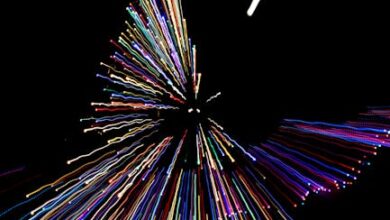The Evolving Landscape of Visual AI: Beyond Single-Shot Understanding

In our increasingly visual world, AI’s ability to “see” and understand what’s happening in images is no longer just a futuristic concept; it’s a fundamental requirement. From autonomous vehicles navigating complex environments to medical diagnostic tools sifting through scans, the demand for sophisticated visual intelligence is soaring. Yet, traditional AI models often grapple with the sheer complexity of real-world visual data, especially when it involves not just one, but multiple images, or even intricate details within a single frame.
Imagine asking an AI to summarize a multi-panel comic strip, or to diagnose an issue from a series of X-rays taken from different angles. It’s not enough to process each image in isolation; the AI needs to understand the relationships, the subtle cues, and the overarching narrative that emerges when all visual pieces are considered together. This is precisely where the innovative work on Visual Adapters, and specifically the MIVPG (Multiple Instance Visual Prompt Generator) model, enters the spotlight, promising a more nuanced and powerful approach to multimodal understanding.
The Evolving Landscape of Visual AI: Beyond Single-Shot Understanding
For a long time, the focus in computer vision has been on perfecting models for single-image tasks. Can it identify the object? Can it segment the scene? These are vital questions, but they often simplify the reality that AI systems operate in a world brimming with interconnected visual information. Multimodal learning, where AI processes information from various sensory inputs (like text and images), has been a significant leap, allowing models to grasp context that a single modality might miss.
However, even within the visual domain itself, challenges persist. How do you efficiently train a model to not only recognize objects in a single image but also to connect the dots across an entire album of related photos? Or, more intricately, how does it make sense of an image where only a few small, critical patches hold the key to understanding the entire scene? This is where the concept of Multiple Instance Learning (MIL) becomes incredibly relevant, and MIVPG builds directly upon its principles.
MIL is fascinating because it allows models to learn from “bags” of instances, where only some instances in the bag might be relevant to the final outcome, and we don’t know which ones beforehand. Think of it like a detective sifting through a stack of clues; not every clue is damning, but the collective weight and correlation of a few key pieces lead to the solution. MIVPG applies this powerful paradigm to visual prompts, allowing AI to dynamically identify and focus on the most pertinent visual information, whether it’s scattered across multiple images or hidden within the granular details of a single one.
Under the Hood: MIVPG’s Intelligent Approach to Visual Comprehension
At its core, MIVPG is designed to be a highly effective visual adapter. It’s not about retraining massive foundation models from scratch, which is often prohibitively expensive and time-consuming. Instead, MIVPG acts as a sophisticated bridge, enhancing existing frozen language and visual models, allowing them to interpret complex visual inputs more intelligently. This strategy makes it an incredibly efficient and scalable solution for integrating advanced visual understanding into various AI applications.
The magic happens through its integration of attention-based Visual Prompt Generators (VPGs) with the robust framework of Multiple Instance Learning. This combination enables MIVPG to not just passively observe visual data but to actively query and correlate information, discerning meaningful patterns even when the input is sparse, noisy, or varied. It’s about moving beyond mere pixel-level analysis to a more profound, relational understanding of visual content.
A Glimpse at the General Setup
In the experimental setup, the researchers leveraged powerful existing models as their foundation. BLIP2, a state-of-the-art model known for its image-to-language capabilities, initialized with FLAN-T5-XL, served as the backbone. Crucially, MIVPG itself was initialized with weights from QFormer, a transformer-based module known for its ability to extract visual features relevant to language queries. The genius here is that while the large language model and visual encoder (ViT-G, which encodes images into 224×224 patch embeddings) remained frozen, only MIVPG was updated during training. This focus on training just the adapter highlights MIVPG’s efficiency and its role as a targeted enhancement, rather than a full system overhaul.
This approach has a practical benefit: it means that MIVPG can be fine-tuned relatively quickly and with less computational overhead, making it accessible for a broader range of applications and research. The observation that unfreezing the visual encoder didn’t yield significant improvements on smaller datasets further reinforces MIVPG’s effectiveness as a standalone adapter, capable of extracting valuable insights without needing to tamper with the core visual perception mechanisms.
Navigating Complexity: MIVPG Across Diverse Visual Scenarios
To truly test MIVPG’s mettle, the researchers devised a series of escalating challenges, mimicking the varied visual data an AI might encounter in the real world. These scenarios brilliantly showcase MIVPG’s flexibility and power, moving from singular visual analysis to intricate multi-image correlation.
Scenario 1: The Solo Act – Single Image, Many Patches
The first scenario tackled what might seem like the most straightforward task: understanding a single image. However, even here, MIVPG approaches it with nuance. In this context, the individual patches within the image are considered as instances. Imagine a high-resolution photograph of a busy street. A traditional model might try to process the whole image at once, or rely on predefined bounding boxes. MIVPG, by treating patches as instances, can dynamically identify and give more weight to specific visual cues — perhaps a distant road sign, a particular facial expression, or a unique architectural detail — without needing explicit supervision for each object. This ability to discern the most relevant visual “instances” within a single frame is a foundational strength, demonstrating its granular understanding.
Scenario 2: Orchestrating Multiple Images – General Embeddings
Next, the complexity increased. In this scenario, samples included multiple images, but each image was treated as a general embedding – essentially, a high-level summary of its content. Think of a presentation slide deck, where each slide is an image, and you want an AI to understand the overall theme by looking at all of them. MIVPG’s task here was to synthesize information from these distinct, yet potentially related, visual sources. It’s about aggregation and cross-referencing. This capability is crucial for tasks like medical diagnosis from multiple scan views, summarizing visual narratives from photo collections, or even analyzing sequential frames in a video where each frame contributes a piece to the larger story.
Scenario 3: The Deep Dive – Multi-Image, Multi-Patch
This is where MIVPG truly shines and tackles the most challenging real-world scenarios. Here, samples comprised multiple images, and each of those images contained multiple patches that needed to be considered. This isn’t just about combining summaries; it’s about deeply analyzing individual parts within multiple visuals and then understanding how those parts correlate across the entire set. It’s the ultimate test of “Unveiling Instance Correlation in MIVPG for Enhanced Multi-instance Scenarios.”
Consider an AI inspecting product quality on an assembly line. It might receive several images of the same item from different angles, and within each image, it needs to check various small components for defects. MIVPG’s ability to not only process patches within each image but also to understand the relationships and anomalies across all images simultaneously offers a powerful solution. This scenario truly highlights MIVPG’s capacity for complex reasoning, allowing it to identify subtle patterns or inconsistencies that would be missed by simpler concatenation or averaging methods.
Pushing the Boundaries of Visual Intelligence
The MIVPG model represents a significant step forward in how AI can interpret and reason about visual information. By intelligently leveraging Multiple Instance Learning and integrating it seamlessly with powerful foundation models, MIVPG offers a robust and efficient solution for scenarios ranging from single-image deep dives to complex multi-image, multi-patch correlations. The ability to achieve this by only training the adapter, leaving larger models frozen, speaks volumes about its practical applicability and efficiency in a world where computational resources are always a consideration.
As AI continues to become an indispensable part of our daily lives and industries, models like MIVPG will be crucial in building systems that can not only “see” but truly “understand” the visual world in all its intricate, multi-layered complexity. This paves the way for more intuitive, accurate, and powerful AI applications across virtually every domain, ultimately bringing us closer to AI that genuinely perceives and interprets the world as humans do – if not better, in some specialized tasks.





